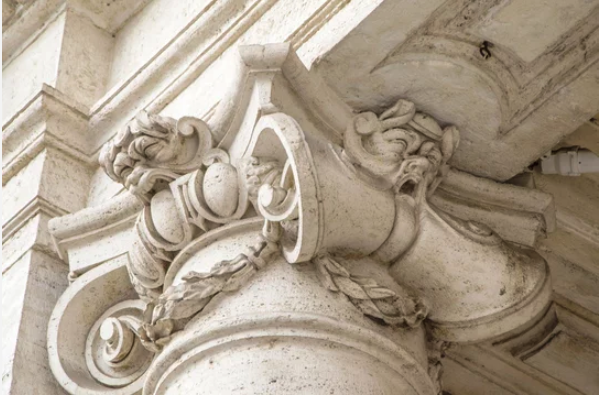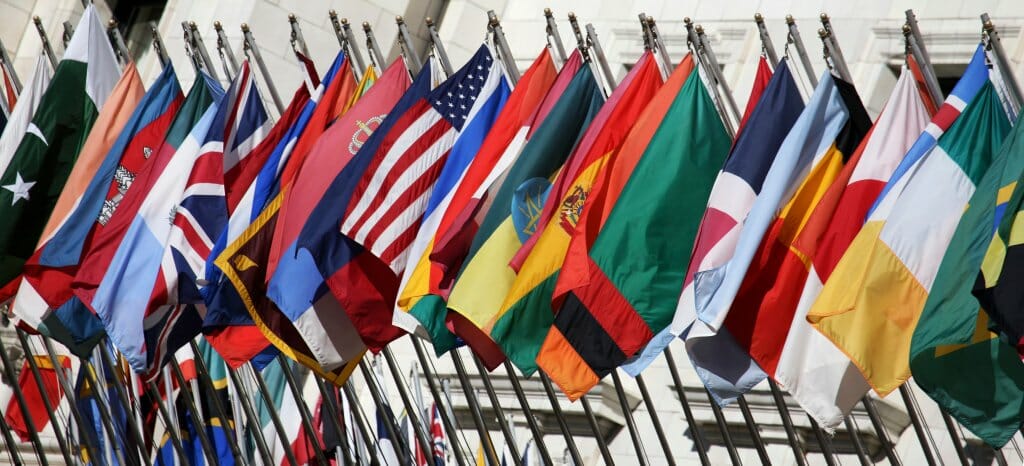Undergraduate Fellow Jake Barnett’s report from Jordan
Jake Barnett | May 13, 2015
Clausewitz’s famous assertion that war is the continuation of politics by other means strikes me as somewhat imperfect, if only because I have always felt that special operations are far too exciting to be related to politics. With that said, being a small country in a volatile region, Jordan is known to rely heavily on the various special operations units as a tool of national power. At the heart of Jordan’s special operations community is the King Abdullah II Special Operations Training Center, Jordan’s Fort Bragg, which each year hosts the Warrior Competition in which elite units from around the world compete in special operations training exercises. While recent champions have included Germany’s famous GSG9, US Marine Recon and China’s Snow Leopard Commandos, Jordan enters the most teams every year to showcase the kind of men that KASOTC produces. This year I had the incredible opportunity to see them get put to the test.
The opening ceremony was itself quite a spectacle: In the grandstand sat King Abdullah II himself, surrounded by an entourage of top generals and men in sleek black suits who made no attempt to hide their affiliation with the Mukhabarat (General Intelligence Directorate), as well as generals from the USA, Russia, China, France and Italy to name a few. Before the 43 teams representing 19 countries were introduced, the Jordanians had their turn to remind us that we were on their turf. Jordan’s elite 71st Counter Terrorist Battalion simulated a hostage rescue on a large airbus parked on the tarmac in front of the grandstand. The men, clad in black tactical gear and balaclavas, rode in on a convoy of siren-blaring GMCs and skid to halt under the plane before they set up two portable stair cases at the plane’s rear and front exits. On cue, each five man team opened their door and filed inside, emerging seconds later with the “hostage.”
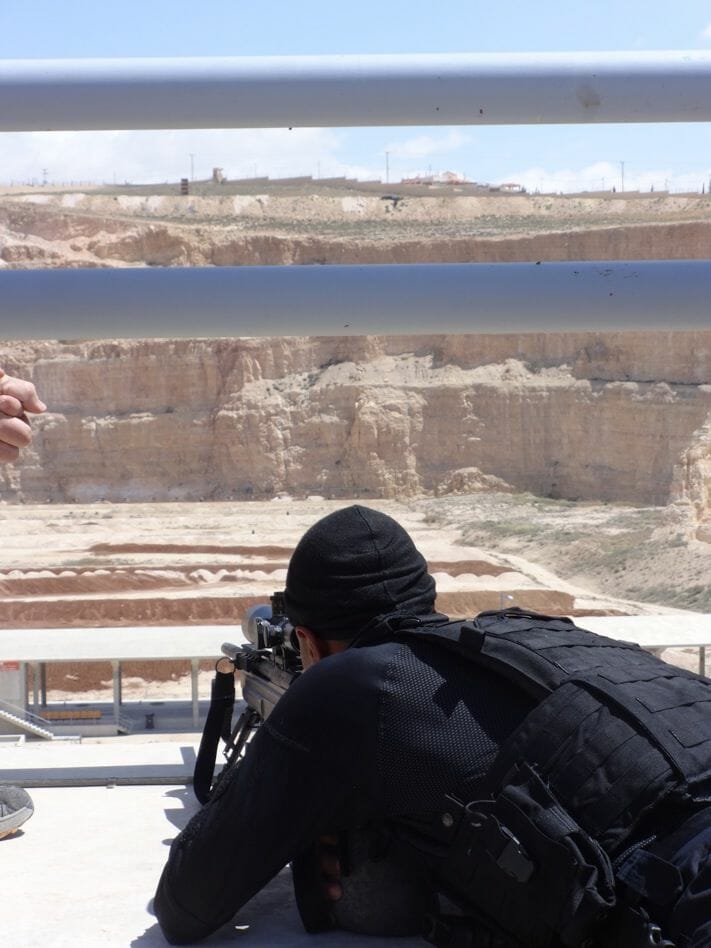
Pic: Jordanian sniper
The men hopped back into the SUVs and pulled off a series of impressive if somewhat terrifying “defensive driving” maneuvers while at the same time a pair of MH-6 Little Birds flew low over the tarmac and opened up on a series of targets with their miniguns. Since there had been no room in the stands when we arrived, my friends and I were among a crowd standing in an adjacent field where the birds decided to empty their cannons. As an explosion ripped up a sizable chunk of earth some 50 meters from me I began to wonder if the Jordanian Army had a concept of “Danger Close,” and I speculated as to what an insurance hassle it would be for UT if one of their students were to be injured by Royal Jordanian Army rocket fire.
Shortly after the explosions ended, the Royal Jordanian Air Force showed off their proudest new addition to the fleet, the AC-235, which they introduced as a next-gen light gun ship. I soon learned, however, that it is in fact a Spanish medium transport aircraft on which the Jordanians spent three years and millions of dollars before successfully adding a 30mm cannon and a pair of rocket pods. After the AC-235 had done a low flyover a Black Hawk quickly floated into position over a nearby building and dropped several ropes onto the roof. 6 men were out of the chopper in seconds and within a minute they had cleared the building and were out the front door with “suspects” in custody. My ears were still ringing, but I was nonetheless impressed by the efficiency of Unit 71.
Without having seen any schedule, I returned the following day hoping to simply stumble onto one of the events, and by complete chance I ran into one of the event organizers, who happened to be an American contractor and former Army Ranger. When he heard that I had come by taxi and had no affiliation with any team, he just laughed and suggested I hang out with him as he monitored each event. This proved to be quite an opportunity as at each range I would walk straight past the other spectators, duck under some caution tape and sit down next to the teams as they loaded their weapons. Any time one of the event organizers, many of whom were American contractors, told me that I couldn’t enter I would just say “I’m with Jim,” to which they would respond, “That a**hole?” before giving me a slap on the back and inviting me over.
Indeed, I had always been under the impression that security contractors were stoic and unpleasant men, but having talked with several this past week I must say they were not only friendly but also very open about their experiences. One described to me the thrill of jumping out of planes with the 82nd over Panama in ‘89 (“People wanna live their life so that when they die they look all pretty in their coffin,” he said. “You should enter that coffin f****d up man!”), another told me about life as a foreigner in Saudi Arabia (spoiler alert: it’s boring), and yet another gave me a five minute crash course in ballistics. All of the contractors had spent several years in the Middle East on various projects and had a high level of respect for the Jordanians, especially compared to their Gulf counterparts. While the Jordanian military receives a lot of assistance from the West, the Kingdom itself is not particularly rich and its soldiers are well-respected for their discipline and commitment. In contrast, the Gulf states, I learned, have a philosophy that money as opposed to hard work is what makes a good army. “They’ll give me a hundred grand and tell me to buy them the coolest looking sniper rifles,” one of the contractors said, “but they’ll just sit around getting dusty cuz no one wants to train more than a few hours a day.”
The first exercise which I witnessed was “hostage rescue,” during which each five man team would sprint down a road, pick up a 100 kilo sand bag dummy, and carry it 50 meters to a pickup truck, which they then push an additional 50 meters as two men position themselves on a parallel berm and shoot at four targets 80 meters away. The men would then grab the hostage and sprint the 100 yards back to the starting line. The first team to go was Russian Counterterrorism Team 1 comprised of some of the fiercest men I have ever seen. All hailing from Chechnya, these men were all around 6’5” and looked as if they were stopping in Jordan on their way to the bear-wrestling Olympics. For the entire duration of the drill they screamed at the top of their lungs in unintelligible Russian (not that intelligible Russian would sound any different to me) with shouts of “Allahu Akbar” and gunfire occasionally adding to the cacophony. I learned the Arabic equivalent of “Bats**t insane” from the Jordanian officer who was keeping score, but even he was impressed when they performed the drill in record time: one minute and 40 seconds, hitting all four targets. Unfortunately they also killed the hostage, as the frail dummy was decapitated when one of the men heaved him onto the truck’s tailgate (“The synthesis of Russian counter-terrorism” one of the spectating Americans chuckled). When the Russians had returned to the starting line with their headless hostage they began embracing each other amid screams of “Allahu Akbar.” I offered one of the men a bottle of water and he turned to me, stared for a moment in confusion and then lunged. I feared for a split second that I might end up like one of the puppies which they undoubtedly have to kill in their training, but the large man simply hugged me and lifted my arm as he shrieked in Russian.
The most interesting drill to watch was the three gun stress shoot: each five-man team had fifteen minutes to send its men one by one through a maze of trenches and then on to three stations where they fired pistols, shotguns and rifles at ranges of 25, 30 and 60 meters respectively. I had the opportunity to watch a number of teams compete in this competition including the US 2nd Marines Special Operations Battalion, Canadian Special Forces, the Saudi Royal guard (at least half of whom were foreigners), the Gendarmerie of the Palestinian Authority, the Lebanese “Black Panther” SWAT team, as well as Kazakh, Czech, Turkish and Afghan teams. There was no clear cut winner among these teams, and nearly everyone struggled with the shotgun (not surprising given the small size of the targets), but I was very impressed by the Czechs, Kazakhs, Canadians and especially the Afghans, who, under the supervision of two Americans from the 5th Special Forces Group, hit the most targets and finished the drill with only seconds remaining. The US Marines, who were quite friendly and talkative, performed superbly in the pistol and shotgun portions but were somewhat lackluster with their M4s. “We rarely practice with M4s cuz rifle shooting is the easiest and most basic,” one of the Marines told me. “Kind of ironic cuz it really bit us in the ass today.”
As interesting as the actual event itself was the opportunity to see how the men of the various units interacted with one another. As each team waited for their turn to run through the drill, boredom took hold and the various nations began mingling with each other. The Canadians and Afghans joked about Justin Bieber; the Americans muttered Borat references when the Kazakhs arrived; the Jordanians cheered for the Palestinians when they went to the range, unsurprising given the percentage of Jordanians who are of Palestinian origin; and the Americans and Canadians talked about beer and hunting with each other as if they were regular acquaintances at the bar. Most of the men were surprisingly friendly and I was impressed by the diversity of characters whom I met. There was a large Czech Captain who had Plato and Virgil tattooed across his forearms and was a PhD candidate in classics, a Turkish soldier who had trained at Ft. Bragg and knew the Boston Celtics better than I did, and a Lebanese sniper who had been a professional bodybuilder and then gone to seminary before joining the “Black Panthers.”
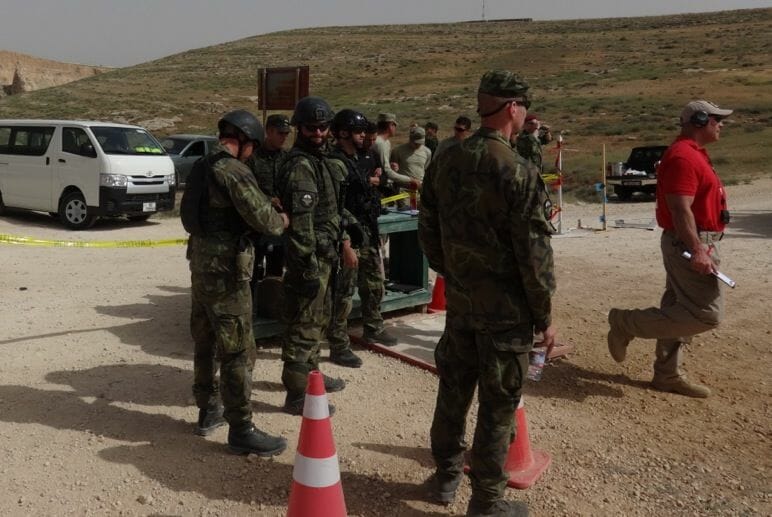
Pic: Czech soldiers chatting
On the final day of the competition I returned to watch the King’s Challenge, a series of five exhausting drills in which each team is required to sprint several kilometers. After all, you can’t see how good a unit really is until you see them compete with all the wind sucked out of them. I spent most of the day at the top of a 25 meter commander tower from which each team’s sniper, having just completed a semi-amphibious obstacle course and sprinted up eight flights of stairs, would attempt to hit five targets at a distance of 500 meters. Given how exhausted the men were the shooting was not top notch. Of the several snipers I saw most only hit one or two, if any, although a Jordanian sniper had hit all five earlier in the day.
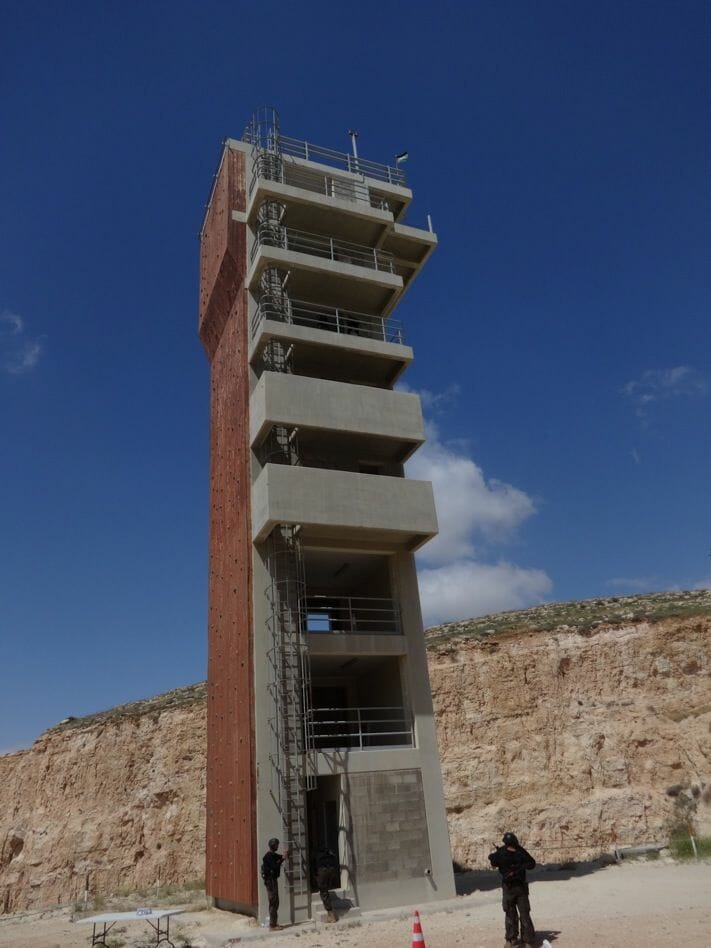
Pic: Tower
Nearly every sniper used an L96 rifle with Winchester .308 ammo, a small but effective bullet at ranges up to 1,000 meters. One sniper from the Special Forces of Brunei Darussalam (which ironically enough means “House of peace”) used Lapua Magnum .338 ammo, which is both an anti-personnel and an anti-material bullet. Apparently this means that it packs quite a punch: Sitting a few feet behind the sniper, who managed to hit two targets, I could feel a strong pinch in my sinuses every time he fired. The deafening sound and crushing pressure of the shot was enough to make me flinch, something which I was intent on avoiding lest I distract and consequently anger the man who is trained to kill from half a mile away.
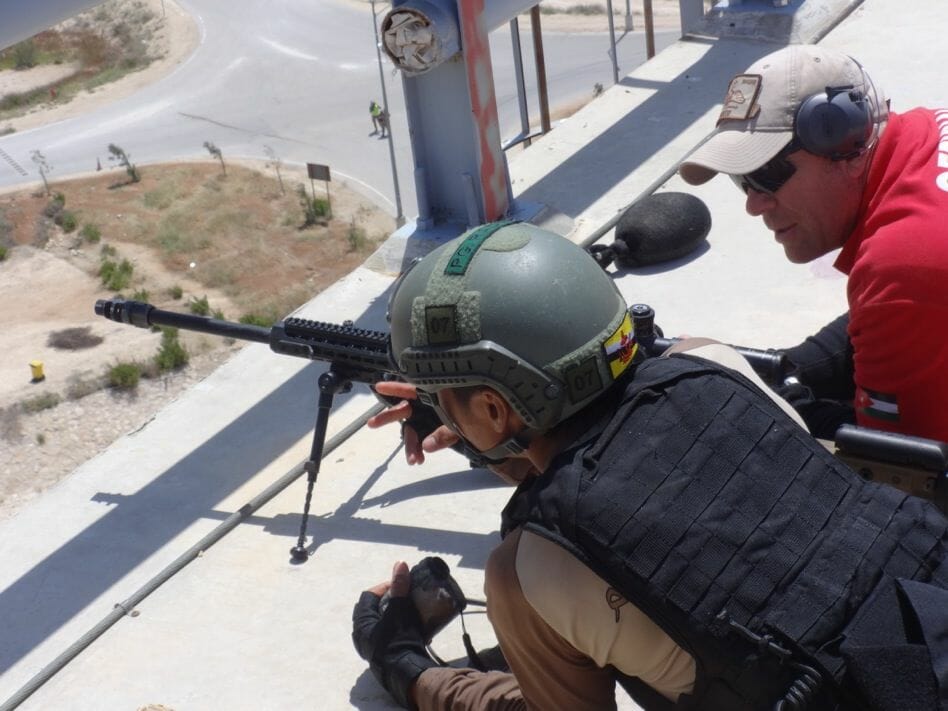
Pic: Brunei sniper
I had to leave the competition before the end of the King’s Challenge and I still do not know which team earned the title of champion. The event staff seemed to think that two of the Jordanian teams, the Russians and the Chinese Snow Leopard Commandos had performed best but the official results have still not been posted. Whoever won may someday soon end up in the news as the anonymous unit behind some impressive hostage rescue or the capture of a high value target; and even though I’ll never know their names or the details of their operations, after this past week, I at least have a better appreciation of what it takes to do their job.

